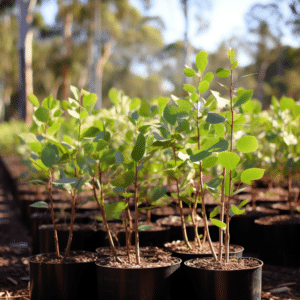Known for their aromatic leaves and towering height, eucalyptus plants are a favorite among garden enthusiasts and landscapers. These evergreen trees native to Australia have adapted to various climates worldwide, making them a versatile addition to any garden or indoor space. However, to ensure their healthy growth and longevity, understanding the essentials of eucalyptus plant care is crucial.
Understanding Eucalyptus Plants

Eucalyptus plants belong to the Myrtaceae family and consist of over 700 species. They are renowned for their fast growth, reaching heights of up to 180 feet in optimal conditions. While most eucalyptus plants are trees, some species are shrubs, suitable for smaller spaces. Their leaves, rich in essential oils, are used in various industries, including pharmaceuticals, perfumery, and even as a natural insect repellent.
These plants are characterized by their peeling bark, which reveals a smooth and colorful trunk underneath. The leaves of the eucalyptus plant are typically a vibrant green, although some species boast blue, silver, or even rainbow-colored foliage. The flowers, usually white or cream-colored, are a favorite among pollinators, adding to the plant’s ecological value.
Optimal Growing Conditions
Climate and Sunlight
Eucalyptus plants thrive in full sun exposure and are best suited to USDA hardiness zones 7 through 11. While they can tolerate light shade, insufficient sunlight can lead to leggy growth and a decrease in the production of essential oils. These plants are tolerant of a wide range of temperatures but may suffer in prolonged periods of extreme cold or heat.
Indoor eucalyptus plants should be placed near a south-facing window or under grow lights to ensure they receive adequate light. Regular rotation of the plant can also promote even growth and prevent the plant from leaning towards the light source.
Soil and Watering
Eucalyptus plants prefer well-draining soil to prevent waterlogging and root rot. A mixture of loam, sand, and a bit of organic compost often provides the ideal balance of drainage and nutrients. These plants are drought-tolerant once established, but regular watering during the growing season can promote lush growth.
Indoor eucalyptus plants may require more frequent watering, especially during dry winter months. However, it’s essential to let the top layer of soil dry out between waterings to prevent overwatering.
Planting and Pruning

Planting
When planting eucalyptus, it’s crucial to give them plenty of space to grow. These plants can quickly become large and may overshadow other plants if not given adequate room. The best time to plant eucalyptus is during the late spring or early summer when the soil has warmed.
For indoor eucalyptus plants, choose a large pot with ample drainage holes. The pot should be large enough to accommodate the plant’s rapid growth but not so large that the soil stays wet for extended periods.
Pruning
Regular pruning can help maintain the size and shape of your eucalyptus plant, especially for indoor plants or shrub species. Pruning should be done in late winter or early spring before the new growth starts. Always use sharp, clean tools to prevent disease transmission.
Remove any dead or diseased branches first, followed by any branches that are crossing or rubbing against each other. For larger trees, it may be necessary to hire a professional arborist to ensure the tree is pruned safely and correctly.
Pest and Disease Management

While eucalyptus plants are relatively pest-resistant, they can occasionally be affected by pests like aphids, scale, and eucalyptus longhorned borers. Regular inspection of your plant can help catch any infestations early before they become a significant problem.
Eucalyptus plants can also be susceptible to certain diseases, including eucalyptus rust, canker, and leaf spot. These diseases can often be prevented or mitigated by ensuring your plant has proper air circulation, avoiding overhead watering, and promptly removing any diseased leaves or branches.
Harvesting and Uses
Eucalyptus leaves can be harvested at any time and are often used in floral arrangements, homemade remedies, and crafts. To harvest, simply cut the branches at the base and hang them upside down in a dry, dark place to dry out.
Beyond their practical uses, eucalyptus plants are a beautiful addition to any landscape or indoor space. Their unique foliage, aromatic scent, and fast growth make them a rewarding plant to grow and care for.
Conclusion
With the right care and attention, eucalyptus plants can thrive in a variety of settings. Whether you’re growing them for their aesthetic appeal, aromatic leaves, or ecological benefits, understanding the basics of eucalyptus plant care can ensure your plants stay healthy and vibrant for years to come.